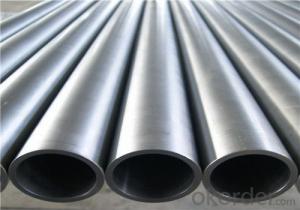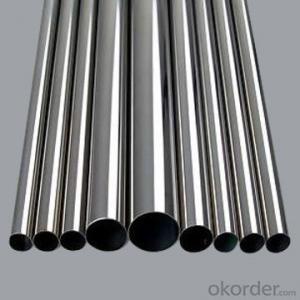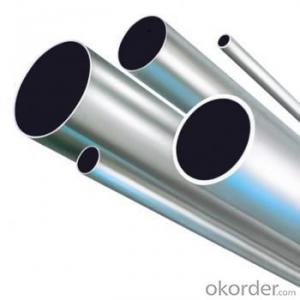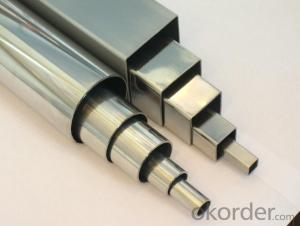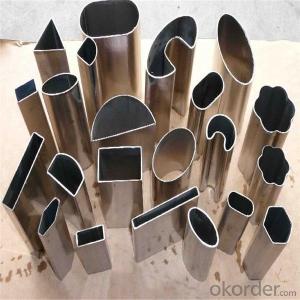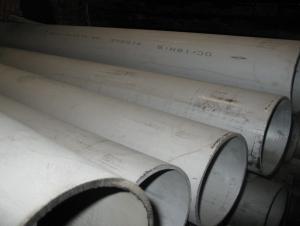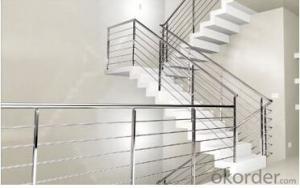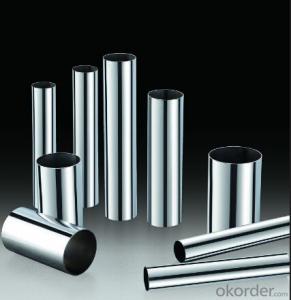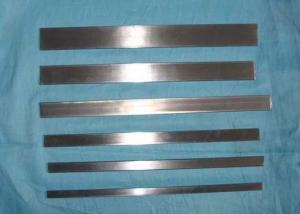STAINLESS STEEL PIPES 201 410 304 316 pipes
- Loading Port:
- China Main Port
- Payment Terms:
- TT OR LC
- Min Order Qty:
- -
- Supply Capability:
- -
OKorder Service Pledge
OKorder Financial Service
You Might Also Like
Description:
Stainless Steel Pipe
Material:
304 321 316 310
Packing:
In bundle
MOQ:
5 TONS
Comparison of standardized steels
| EN-standard Steel no. k.h.s DIN | EN-standard Steel name | SAE grade | UNS |
|---|---|---|---|
| 1.4109 | X65CrMo14 | 440A | S44002 |
| 1.4112 | X90CrMoV18 | 440B | S44003 |
| 1.4125 | X105CrMo17 | 440C | S44004 |
| | | 440F | S44020 |
| 1.4016 | X6Cr17 | 430 | S43000 |
| 1.4408 | G-X 6 CrNiMo 18-10 | 316 | |
| 1.4512 | X6CrTi12 | 409 | S40900 |
| | | 410 | S41000 |
| 1.4310 | X10CrNi18-8 | 301 | S30100 |
| 1.4318 | X2CrNiN18-7 | 301LN | |
| 1.4307 | X2CrNi18-9 | 304L | S30403 |
| 1.4306 | X2CrNi19-11 | 304L | S30403 |
| 1.4311 | X2CrNiN18-10 | 304LN | S30453 |
| 1.4301 | X5CrNi18-10 | 304 | S30400 |
| 1.4948 | X6CrNi18-11 | 304H | S30409 |
| 1.4303 | X5CrNi18-12 | 305 | S30500 |
| | X5CrNi30-9 | 312 | |
| 1.4541 | X6CrNiTi18-10 | 321 | S32100 |
| 1.4878 | X12CrNiTi18-9 | 321H | S32109 |
| 1.4404 | X2CrNiMo17-12-2 | 316L | S31603 |
| 1.4401 | X5CrNiMo17-12-2 | 316 | S31600 |
| 1.4406 | X2CrNiMoN17-12-2 | 316LN | S31653 |
| 1.4432 | X2CrNiMo17-12-3 | 316L | S31603 |
| 1.4435 | X2CrNiMo18-14-3 | 316L | S31603 |
| 1.4436 | X3CrNiMo17-13-3 | 316 | S31600 |
| 1.4571 | X6CrNiMoTi17-12-2 | 316Ti | S31635 |
| 1.4429 | X2CrNiMoN17-13-3 | 316LN | S31653 |
| 1.4438 | X2CrNiMo18-15-4 | 317L | S31703 |
| 1.4362 | X2CrNi23-4 | 2304 | S32304 |
| 1.4462 | X2CrNiMoN22-5-3 | 2205 | S31803/S32205 |
| 1.4539 | X1NiCrMoCu25-20-5 | 904L | N08904 |
| 1.4529 | X1NiCrMoCuN25-20-7 | | N08926 |
| 1.4547 | X1CrNiMoCuN20-18-7 | 254SMO | S31254
|
Stainless steel’s resistance to corrosion and staining, low maintenance and familiar lustre make it an ideal material for many applications. There are over 150 grades of stainless steel, of which fifteen are most commonly used. The alloy is milled into coils, sheets, plates, bars, wire, and tubing to be used in cookware, cutlery, household hardware, surgical instruments, major appliances, industrial equipment (for example, in sugar refineries) and as an automotive and aerospace structural alloy and construction material in large buildings. Storage tanks and tankers used to transport orange juice and other food are often made of stainless steel, because of its corrosion resistance. This also influences its use in commercial kitchens and food processing plants, as it can be steamcleaned and sterilized and does not need paint or other surface finishes.
Stainless steel is used for jewelry and watches with 316L being the type commonly used for such applications. It can be re-finished by any jeweler and will not oxidize or turn black.
Some firearms incorporate stainless steel components as an alternative to blued or parkerized steel. Some handgun models, such as the Smith & Wesson Model 60 and the Colt M1911 pistol, can be made entirely from stainless steel. This gives a high-luster finish similar in appearance to nickel plating. Unlike plating, the finish is not subject to flaking, peeling, wear-off from rubbing (as when repeatedly removed from a holster), or rust when scratched.
Stainless steel is used for buildings for both practical and aesthetic reasons. Stainless steel was in vogue during the art deco period. The most famous example of this is the upper portion of the Chrysler Building (pictured). Some diners and fast-food restaurants use large ornamental panels and stainless fixtures and furniture. Because of the durability of the material, many of these buildings retain their original appearance.
Type 316 stainless is used on the exterior of both the Petronas Twin Towers and the Jin Mao Building, two of the world's tallest skyscrapers.[17]
The Parliament House of Australia in Canberra has a stainless steel flagpole weighing over 220 tonnes (240 short tons).
The aeration building in the Edmonton Composting Facility, the size of 14 hockey rinks, is the largest stainless steel building in North America.
Cala Galdana Bridge in Minorca (Spain) was the first stainless steel road bridge.
Sant Fruitos Pedestrian Bridge (Catalonia, Spain), arch pedestrian bridge.
Padre Arrupe Bridge (Bilbao, Spain) links the Guggenheim museum to the University of Deusto.[18]
The Unisphere, constructed as the theme symbol of the 1964-5 World's Fair in New York City, is constructed of Type 304L stainless steel as a sphere with a diameter of 120 feet, or 36.57 meters.
The Gateway Arch (pictured) is clad entirely in stainless steel: 886 tons (804 metric tonnes) of 0.25 in (6.4 mm) plate, #3 finish, type 304 stainless steel.[19]
The United States Air Force Memorial has an austenitic stainless steel structural skin.
The Atomium in Brussels, Belgium was renovated with stainless-steel cladding in a renovation completed in 2006; previously the spheres and tubes of the structure were clad in aluminium.
The Cloud Gate sculpture by Anish Kapoor, in Chicago US.
The Sibelius monument in Helsinki, Finland, is made entirely of stainless steel tubes.
The Man of Steel (sculpture) under construction in Rotherham, England.
- Automotive bodies
The Allegheny Ludlum Corporation worked with Ford on various concept cars with stainless steel bodies from the 1930s through the 1970s, as demonstrations of the material's potential. The 1957 and 1958 Cadillac Eldorado Brougham had a stainless steel roof. In 1981 and 1982, the DeLorean DMC-12 production automobile used stainless steel body panels over a glass-reinforced plasticmonocoque. Intercity buses made by Motor Coach Industries are partially made of stainless steel. The aft body panel of the Porsche Cayman model (2-door coupe hatchback) is made of stainless steel. It was discovered during early body prototyping that conventional steel could not be formed without cracking (due to the many curves and angles in that automobile). Thus, Porsche was forced to use stainless steel on the Cayman.
- Passenger rail cars
Rail cars have commonly been manufactured using corrugated stainless steel panels (for additional structural strength). This was particularly popular during the 1960s and 1970s, but has since declined. One notable example was the early Pioneer Zephyr. Notable former manufacturers of stainless steel rolling stock included the Budd Company (USA), which has been licensed to Japan's Tokyu Car Corporation, and the Portuguese company Sorefame. Many railcars in the United States are still manufactured with stainless steel, unlike other countries who have shifted away.
- Aircraft
Budd also built an airplane, the Budd BB-1 Pioneer, of stainless steel tube and sheet, which is on display at the Franklin Institute.
The American Fleetwings Sea Birdamphibious aircraft of 1936 was also built using a spot-welded stainless steel hull.
The Bristol Aeroplane Company built the all-stainless steel Bristol 188 high-speed research aircraft, which first flew in 1963.
The use of stainless steel in mainstream aircraft is hindered by its excessive weight compared to other materials, such as aluminum.
- Jewelry
Valadium, a stainless steel and 12% nickel alloy is used to make class and military rings. Valadium is usually silver-toned, but can be electro-charged to give it a gold tone. The gold tone variety is known as Sun-lite Valadium
- Q: What is the difference between bright annealed and annealed pickled stainless steel pipes?
- Bright annealed and annealed pickled stainless steel pipes are two different types of surface finishes for stainless steel pipes. Bright annealed stainless steel pipes go through a process called annealing, where the pipes are heated to a specific temperature and then cooled slowly. This process helps to relieve internal stresses and improve the overall ductility and corrosion resistance of the steel. After annealing, the pipes are then subjected to a bright annealing process, which involves heating the pipes in a controlled atmosphere to a high temperature and then rapidly cooling them. This process produces a smooth, shiny, and reflective surface finish on the pipes. On the other hand, annealed pickled stainless steel pipes also go through an annealing process to improve their properties. However, after annealing, these pipes are pickled. Pickling involves immersing the pipes in a solution of acid, such as hydrochloric or sulfuric acid, to remove any scale, oxides, or contaminants on the surface of the steel. This process helps to clean and purify the surface, leaving a dull, matte finish on the pipes. In summary, the main difference between bright annealed and annealed pickled stainless steel pipes lies in their surface finish. Bright annealed pipes have a smooth, shiny, and reflective finish, while annealed pickled pipes have a dull, matte finish. The choice between these two types of finishes depends on the specific requirements and aesthetics of the application.
- Q: What is the difference between annealed and tempered stainless steel pipes?
- The main difference between annealed and tempered stainless steel pipes lies in their structural properties. Annealed stainless steel pipes are heat-treated to eliminate internal stresses and improve ductility, making them more malleable and easier to work with. On the other hand, tempered stainless steel pipes undergo an additional heat treatment process to enhance their strength and hardness. This makes tempered pipes more resistant to deformation and able to withstand higher levels of pressure and stress.
- Q: Can stainless steel pipes be used for brewery equipment?
- Yes, stainless steel pipes can definitely be used for brewery equipment. Stainless steel is a preferred material in brewery setups due to its excellent corrosion resistance, durability, and hygienic properties. It can handle the high temperatures, acidic content, and frequent cleaning required in brewery operations, making it a reliable choice for the construction of pipes used in brewing equipment.
- Q: Are stainless steel pipes suitable for food storage facilities?
- Yes, stainless steel pipes are highly suitable for food storage facilities. Stainless steel is a popular choice in the food industry due to its numerous beneficial properties. Firstly, stainless steel is highly resistant to corrosion, which is essential in food storage facilities where contact with moisture and various food products is common. This resistance ensures that the pipes will not rust or degrade over time, preventing any potential contamination of the stored food. Furthermore, stainless steel pipes are easy to clean and maintain, making them ideal for food storage facilities where strict hygiene standards must be met. The smooth and non-porous surface of stainless steel pipes prevents the accumulation of bacteria, ensuring the stored food remains safe and uncontaminated. Stainless steel is also a non-reactive material, meaning it does not leach any harmful substances into the food. This is particularly important for food storage facilities as it ensures the integrity and quality of the stored food products are maintained. Additionally, stainless steel pipes have excellent strength and durability, allowing them to withstand the high pressures and temperature variations commonly encountered in food storage facilities. This ensures the pipes will not fail or break, providing a reliable and long-lasting solution. In conclusion, stainless steel pipes are highly suitable for food storage facilities due to their corrosion resistance, ease of cleaning, non-reactive nature, and strength. They provide a safe and hygienic environment for storing food, ensuring the integrity and quality of the stored products.
- Q: Can stainless steel pipes be used for paper and pulp industry applications?
- Yes, stainless steel pipes can be used for paper and pulp industry applications. Stainless steel is resistant to corrosion, chemicals, and high temperatures, making it ideal for handling corrosive liquids and chemicals used in the paper and pulp industry. Additionally, stainless steel pipes provide excellent strength and durability, ensuring long-lasting performance in demanding industrial environments.
- Q: What is the welding procedure for stainless steel pipes?
- To achieve a strong and durable joint, stainless steel pipes undergo a specific welding procedure. Typically, the process entails several crucial steps. To begin, it is essential to choose the appropriate welding technique for stainless steel, which is often Tungsten Inert Gas (TIG) welding due to its ability to produce precise and clean welds. Before commencing the welding process, it is necessary to thoroughly clean the stainless steel pipes to eliminate any contaminants like dirt, grease, or oxidation. This can be accomplished using either a degreasing agent or a stainless steel wire brush. Following the cleaning process, the pipes must be aligned and fitted together correctly. It is crucial to ensure that the gap between the pipes remains consistent and even throughout the joint. This can be achieved by temporarily securing the pipes in place using clamps or tack welding. Once the pipes are properly aligned, the TIG welding process can commence. This involves using a TIG torch to create an electric arc between a tungsten electrode and the stainless steel pipes. The intense heat generated by the arc melts the edges of the pipes, creating a fusion between the base metal and the filler material. During the welding process, it is vital to maintain a stable arc length and control the welding speed to achieve a uniform weld bead. Regulating the heat input and controlling the welding parameters can be accomplished by utilizing a foot pedal or a remote control. Throughout the welding process, it is important to safeguard the weld area from contamination. This can be achieved by using shielding gas, such as argon, to establish an inert atmosphere around the weld zone. The shielding gas prevents the weld area from reacting with oxygen and other atmospheric elements that could result in weld defects. Upon completing the welding, it is advisable to perform post-weld cleaning and inspection. This involves removing any slag or spatter that may have formed during the welding process and visually examining the weld for any defects like cracks or discontinuities. In summary, the welding procedure for stainless steel pipes involves cleaning the pipes, aligning and fitting them together, TIG welding with the appropriate arc length and welding speed, shielding the weld area with inert gas, and conducting post-weld cleaning and inspection. By following these steps, a dependable and sturdy weld joint can be achieved for stainless steel pipes.
- Q: What is the difference between ERW and EFW stainless steel pipes?
- Stainless steel pipes can be manufactured using two different methods: ERW (Electric Resistance Welded) and EFW (Electric Fusion Welded). The primary distinction between these two methods is in the welding process employed. In the case of ERW stainless steel pipes, a flat sheet of steel is rolled into a cylindrical shape and then joined together at the edges using a high-frequency electrical current. This process yields a seamless and robust joint, ensuring the pipe's resistance to corrosion and a smooth interior surface. ERW pipes find extensive use in industries such as oil and gas, where durability and strength are crucial. In contrast, EFW stainless steel pipes are produced by melting the edges of two steel pieces together under the application of heat and pressure. This fusion welding process creates a continuous weld throughout the entire length of the pipe, eliminating the need for additional welding. EFW pipes are renowned for their exceptional corrosion resistance and are commonly utilized in environments characterized by high pressure and temperature, such as chemical plants and power generation facilities. To summarize, the primary distinction between ERW and EFW stainless steel pipes lies in the welding process. ERW pipes are formed by welding the edges of a flat sheet, whereas EFW pipes are created by fusing the edges of two steel pieces. Both methods offer distinct advantages and find application in different industries depending on the specific project requirements.
- Q: What is the difference between 304J8 and 316J8 stainless steel pipes?
- The main difference between 304J8 and 316J8 stainless steel pipes lies in their composition and corrosion resistance. 304J8 stainless steel contains 18% chromium and 8% nickel, making it suitable for general-purpose applications. On the other hand, 316J8 stainless steel contains 16% chromium, 10% nickel, and 2% molybdenum, providing increased resistance to corrosion, especially in environments with chlorides or acids. Therefore, 316J8 stainless steel pipes are often used in more demanding applications such as marine environments or chemical processing plants.
- Q: Can stainless steel pipes be insulated with polyethylene naphthalate?
- Yes, stainless steel pipes can be insulated with polyethylene naphthalate (PEN). Polyethylene naphthalate is a high-performance thermoplastic material that offers excellent insulation properties. It has low thermal conductivity, which makes it suitable for insulating pipes and preventing heat loss or gain. Additionally, PEN has good resistance to chemicals, moisture, and UV radiation, making it a durable choice for pipe insulation. However, it is important to ensure that the selected insulation material is compatible with the specific application and operating conditions to ensure optimal performance and longevity.
Send your message to us
STAINLESS STEEL PIPES 201 410 304 316 pipes
- Loading Port:
- China Main Port
- Payment Terms:
- TT OR LC
- Min Order Qty:
- -
- Supply Capability:
- -
OKorder Service Pledge
OKorder Financial Service
Similar products
Hot products
Hot Searches
Related keywords













